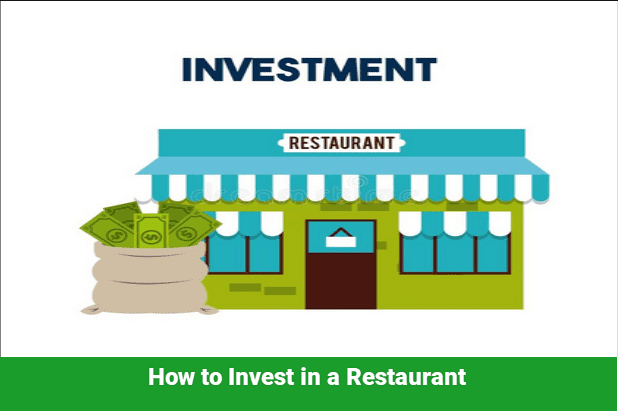How to Invest in a Restaurant 4 Easy Tips

Exploring Restaurant Investments: Get the Facts Here
Hey there,
If you were wondering,
How to Invest in a Restaurant?
But don’t know where to start?
You Are in the Right Place.
Everyone loves the idea of being their boss and running a successful business, and what could be more exciting than opening a thriving restaurant that serves delicious food?
But, entering into the world of restaurant investments isn’t as simple as it may seem.
Luckily, this guide will provide essential advice on how to invest in a restaurant.
We’ll explain the key steps to set up shop confidently and succeed.
So if you’re looking for tips on making intelligent decisions when setting up or expanding your restaurant business, this guide is for you.
Invest in a Restaurant: A Step-by-Step Guide
1 – Decide If You Want to Be an Active or Passive Investor Before Anything Else.
Despite its romanticized appeal, the restaurant industry is not more dangerous than any other profession if those who lack a proper understanding of business aren’t included in the equation. This field often entices those who view money as an abstract concept – but with strategic planning and solid financial insight, it can be just like any other sector.
According to the National Restaurant Association, an estimated 60,000 restaurants open their doors each year, and 50,000 close. Even though it may seem like a large number of businesses are failing in this industry.
Christin Fernandez – director of media relations and public affairs at the association- explains that these closings aren’t always indicative of failure but can be due to owners choosing to shut down one location while opening another. This churn emphasizes how competitive restaurant ownership is.
2 – Invest in Restaurants Directly
If you want to invest in restaurants, the traditional approach is to listen carefully and make an investment.
Acting as a venture capitalist will allow you to join a business with high growth potential early on, getting double-digit shares of its equity and reaping greater rewards should its investments pay off.
Angel investors typically identify potential investments in three distinct ways:
- Word of mouth from other investors
- Through incubators.
- Friends and family
For instance, if you are an accredited investor eyeing a potentially profitable opportunity in Boston’s restaurant industry, Branch Venture Group is the perfect angel investing network for you. With it, you can easily peruse various pitches and business plans to discover your next investment venture.
Angel investing is not for the faint of heart. It requires a great deal of endurance, enthusiasm and significant capital – after all, you may be asked to offer up $100K in exchange for only 10-20% ownership.
With most restaurants folding within five years, investing too much capital into a single concept could be catastrophic to your financial future. Nevertheless, this may still be an option if you have plenty of restaurant expertise and funds ready to invest.
Pros and Cons of Investing in Restaurants Directly
Pros
- Get in early — Immersing yourself in the world of angel investing for restaurants can be a thrilling experience. You’ll have the opportunity to join incubators, listen to pitches, and invest in an up-and-coming concept from its inception.
- Largest profit potential — Investing in the right restaurant early on will be much more profitable than waiting until a Series C to fund your venture and join the hype.
- Own real equity — It is possible to acquire a substantial equity stake at the seed stage, with potential returns in the double digits.
Cons
- Mega-high risk — The odds are better in Sin City than when investing in one restaurant location, given that 80% of them collapse within five years.
- Expensive — Angels regularly invest six-digit figures for an equity stake of 10 percent or lower, leaving little room to diversify their portfolios.
- Time intensive — Selecting the correct restaurant from the beginning can be risky, requiring you to rely on your instincts or gamble without safety measures. Making sure you get it right requires connecting with people in the industry and carefully evaluating business plans.
3 – Invest Through Crowdfunding
Restaurant profit margins are usually quite small, making it difficult to convince traditional lenders to provide a loan. Seed funding is often hard to come by and involves giving away too much equity ownership in exchange. That’s why many restaurateurs gravitate towards crowdfunding as the perfect alternative.
Unlike Kickstarter, other crowdfunding sites are more focused on obtaining donations in return for rewards, early product access, etc., but restaurant crowdfunding websites offer something considerably more impactful.
- Honeycomb Credit Acting like a typical peer-to-peer loan site, investors supply loans to restaurateurs for a fixed interest return over time. The rate of payment varies from 5% up to 14%.
- Mainvest Bypass the traditional fixed interest payment for an innovative revenue-sharing model that gives investors up to 25% return on their investments if they choose wisely.
- FranShares You can invest in new franchise locations, such as restaurants, for approximately five years with anticipated returns between 16% and 21.86%.
Compared to angel investing, crowdfunding for investors is straightforward. The main downside of this investment option is that the returns are limited, with only a potential ~15% if the restaurant succeeds – which isn’t always guaranteed. Nevertheless, crowdfunding may be your best bet if you’re willing to take a slight risk in exchange for helping someone pursue their passion project.
Pros
- Convenient — With innovative platforms like Honeycomb Credit and Mainvest, you can effortlessly register, evaluate potential investments, conduct due diligence investigations, and invest in restaurants – all without ever leaving your home!
- Better selection — By broadening your horizons to multiple platforms, you’ll find numerous opportunities to explore.
- More predictable short-term returns — While operating under either a fixed or revenue-sharing model, crowdfunding investments usually offer beneficial returns for investors (although not promised).
Cons
- No equity — Often, crowdfunding does not involve a traditional exchange of currency for equity but offers fixed interest or revenue-sharing agreements.
- Illiquid — With most restaurant crowdfunding sites (as well as other types of crowdfunding platforms) not offering a secondary market, you are restricted to investing for approximately five years.
- The “default” rate is still high. If new restaurants were to receive a Corporate Credit Rating, their score would most likely be in the lower range of C or D. This signifies that your salary potential and assurance for collecting it all is highly unlikely.
4 – Invest in Restaurant Stocks and ETFs
If you’re uninterested in angel investing and crowdfunding, turning to the stock exchange is always an excellent choice.
The restaurant industry reflects the larger stock market, featuring its revered blue chips, rising stars, and ETFs with manageable risks.
Leading names found on highway signs, such as Starbucks (SBUX), McDonald’s (MCD), and Domino’s Pizza (DPZ), are among these illustrious blue-chip giants that monopolize this sector.
Yum China Holdings, Inc (YUMC) and Kura Sushi USA (KRUS) are rapidly gaining investor attention and admiration.
Both of these corporations have vastly exceeded their current earnings projections. YUMC split from its former parent company, Yum Brands, in 2016, while KRUS is a renowned provider of rotating sushi.
For a safer investment option, think about investing in Exchange-Traded Funds (ETFs) like the Invesco S&P SmallCap Consumer Discretionary ETF (PSCD) and the AdvisorShares Restaurant ETF (EATZ). Both of these funds offer diversified portfolios that help spread out risk, allowing for more stability over time.
While restaurant stocks are slowly recovering from pandemic-era lows, there is no guarantee of long-term success due to challenges like labor shortages, inflation rates that keep increasing, and an increase in takeout-only ghost kitchens.
Therefore expecting high volatility if investing in this sector.
Pros and Cons of Investing in Restaurant Stocks and ETFs
Pros
- Liquid and convenient — While buying, selling, and trading stocks is a relatively quick process that can be done any day of the week, direct investing and crowdfunding come with much longer lockup periods — often lasting over five years.
- Easier to diversify — Investing in restaurant stocks offer a great way to minimize investment risk compared to angel investing and crowdfunding. This is mainly because diversifying your investments becomes significantly easier with stock options than with other forms.
- The post-pandemic world opens up new possibilities for everyone. — By the mid-2020s, restaurants that swiftly adapt to changing consumer tastes could see considerable rewards.
Cons
99% percent of restaurants aren’t listed — If you’re seeking to support local, stocks are not the ideal option for you as mom-and-pop shops and bakeries cannot be found in the Russell 1000.
Furthermore, post-COVID brings a slew of volatility; labor shortage issues, wage debates, unionization attempts, mounting inflation rates, and continued supply chain complications create instability among restaurant stocks.
Precautions to take when investing in a restaurant
1 – Review the business plan and cash-flow projections.
If you’re considering investing in a new restaurant venture, take the time to check out its business plan and make sure that it has been well-crafted.
Additionally, look for local data on market trends and see if the projections made by the owner are realistic. This approach ensures your investment is sound without relying solely on past performance records or tax returns!
Wall Street evaluates earnings before taxes, interest, depreciation, and amortization – but restaurant owners pay attention to the cash flow from operations.
If a business states it needs an investment of $1.2 million, I’d be skeptical about its success if its projected cash flow only adds up to one-third of that sum: $400,000.
Therefore it is essential to thoroughly assess such figures before investing in dining establishments.
Investing too much money to open a restaurant is an all-too-common blunder that business owners and investors often make.
According to Doug Jacob, partner of Toro Restaurant Group in New York City: “The initial capital required for launching a new eatery should be carefully examined.” He warns against utilizing millions on decorations with no practical purpose and the high cost associated with property rental in today’s market conditions.
According to Jacob, restaurants are one of the most challenging ventures yet possess an extremely straightforward system. Success is unlikely if your fixed costs exceed a particular percentage – irrespective of how high-quality you may be!
2 – Look at occupancy costs
According to Jacob, this is a vital determining factor in assessing whether the deal was conducted accurately or would generate enough revenue for an investor.
Additionally, you should review how much money must be invested into occupying and sustaining the area, which includes rent, insurance, common area maintenance, and taxes; typically, 8% of sales is deemed acceptable by industry standards, but 10% could work in New York.
3 – Consider a restaurant’s scalability.
For institutional investors with an eye on the exit value, it’s critical to consider how a company recruits the correct talent for growth and invests in its brand rather than focusing exclusively on cash flow.
When it comes to hiring a restaurant operator, experience is key. According to Greg Wank of Anchin, Block, and Anchin’s food and beverage service group in New York, “The ideal situation would be an owner-operator who has proven their mettle through prior successful ventures. Investing into someone with past failure but now success can create much less risk for the business.”
Should You Invest in Restaurants at All?
Investing in the perfect restaurant, whether it’s a renowned establishment or an up-and-coming eatery, can be tricky at any time.
Even though local restaurants may only bring in 3% to 5% profits each year, they still offer potential rewards for passionate and risk-tolerant investors looking to invest in 2022.
While even chain eateries like McDonald’s and Chipotle are confronted with an unpredictable future due to supply chain complications, inflationary prices, and fluctuating diner tastes, money is still being made from this sector if profit isn’t your only driving force.
Consequently, those familiar with restaurant management ought to think about making a venture into this industry come next year.
Pros and Cons of Investing in Restaurants
As we discussed the advantages and disadvantages of investing in a restaurant, let’s quickly review some general benefits and drawbacks to keep in mind.
Pros
- A shift in trends could quickly create triumphant results. — The food industry is experiencing unprecedented growth and advancement, presenting a golden opportunity for you to secure sizable profits by investing in a restaurant! From delivery applications to plant-based diets, the potential rewards are immense. Don’t procrastinate – take advantage of this unmissable moment today and enjoy its fruits tomorrow!
- An unprecedented number of points of access. —For those looking to invest in the restaurant industry, never before have so many options been available- from stocks and ETFs to many crowdfunding platforms.
- Show your support for the local restaurant owners in your community today — Passionate foodies and ESG investors can find tremendous satisfaction in supporting the perfect restaurant at this critical juncture.
Cons
- All too often, data can be severely limited — While just a select few restaurants are listed on the stock exchange, researching the other 99% can be an arduous task. Even with thorough pitch decks and plenty of analytics data, accurately predicting a restaurant’s growth trajectory is like throwing darts in the dark.
- Unfortunately, many restaurants don’t survive even a year in business — Opening a restaurant is an uphill battle and, unfortunately, it has been calculated that almost 60% of new restaurants fail in the first year, with 80% failing within five years – far worse than the average 90% failure rate for most startups.
- Unpredictability in the industry could heavily impact restaurant stocks – In the coming months, staffing shortages, wage debates, attempts to unionize, food costs increasing, and supply chain issues could all severely influence restaurant stocks. Moreover, with interest rates looming, these challenges are becoming increasingly prevalent.
Conclusion
With a wide range of opportunities available, investing in restaurants can prove to be an intimidating endeavor. The alarming rate of business failure has the potential to discourage any inexperienced investor; however, those with both enthusiasm and resources will find it a delectable challenge.
Jeff Smith is a Restaurant Consultant with over 20 years of hospitality experience ranging from server to owner and general manager. He focuses on Restaurant POS technology as well as restaurant marketing. Make sure to check out our world famous restaurant resources page for a comprehensive offering of hand picked resources and tools to help your business. You can also check out some of our other restaurant business articles.



